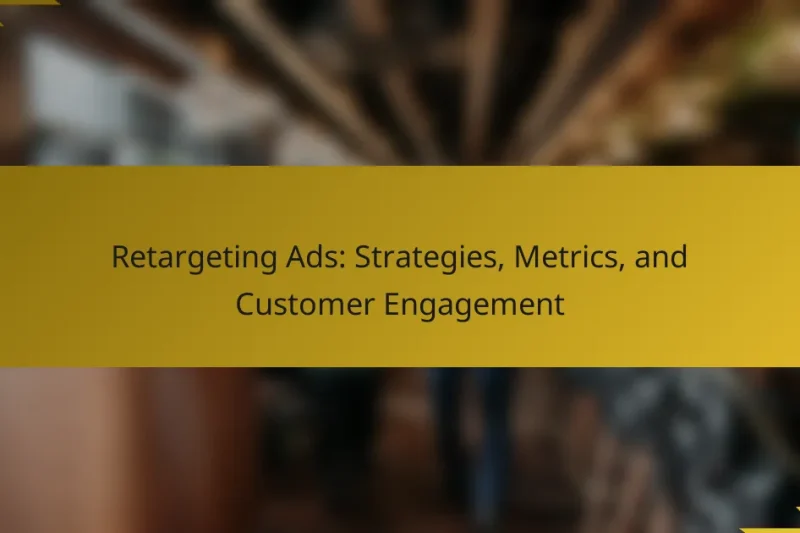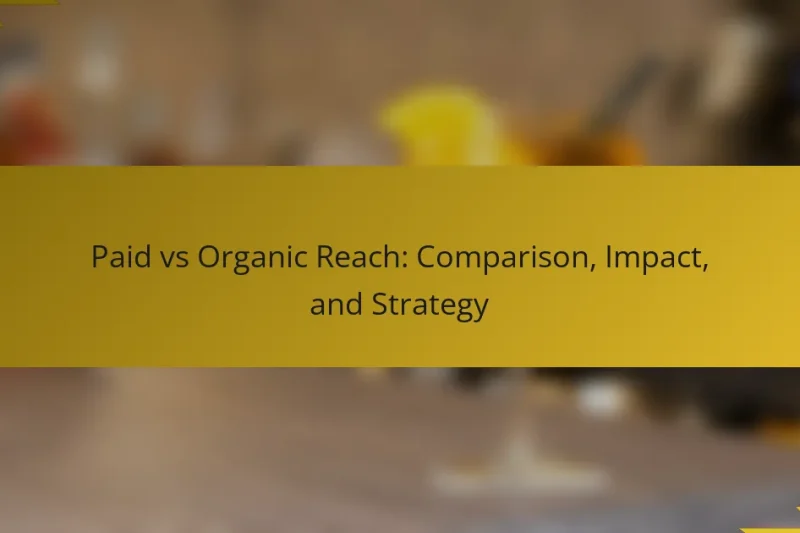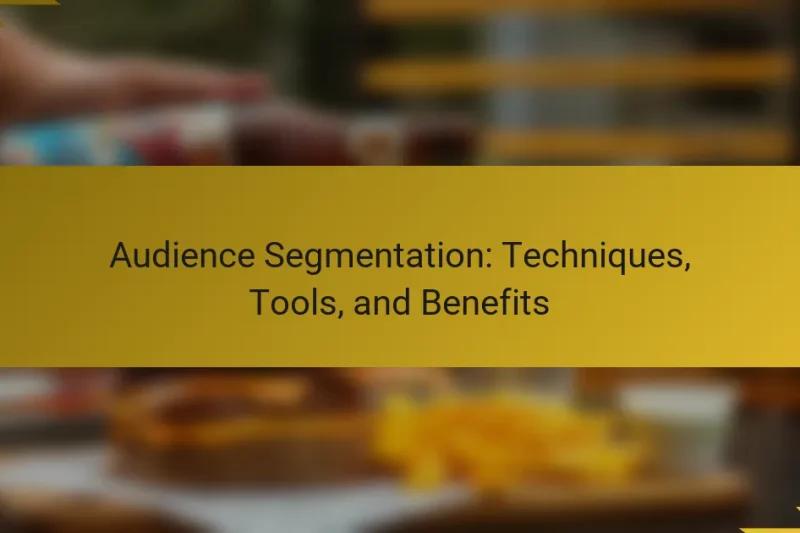Targeted Facebook ads are a powerful tool for reaching specific audiences and maximizing your advertising budget. … Targeted Facebook Ads: Setup, Audience, and BudgetingRead more
Social Media Marketing for Breweries: Targeted Advertising Techniques
Social media marketing presents breweries with a powerful opportunity to connect with their target audiences through targeted advertising techniques. By leveraging platforms like Facebook and Instagram, breweries can effectively showcase their products, promote events, and foster brand loyalty within local communities. Understanding customer demographics and interests allows for the creation of tailored campaigns that resonate with specific groups, maximizing engagement and reach.
Retargeting Ads: Strategies, Metrics, and Customer Engagement
Retargeting ads are a powerful tool for re-engaging potential customers who have shown interest in your … Retargeting Ads: Strategies, Metrics, and Customer EngagementRead more
Paid vs Organic Reach: Comparison, Impact, and Strategy
In the digital marketing landscape, understanding the differences between paid and organic reach is crucial for … Paid vs Organic Reach: Comparison, Impact, and StrategyRead more
Audience Segmentation: Techniques, Tools, and Benefits
Audience segmentation is a crucial marketing strategy that involves categorizing consumers based on shared characteristics, enabling … Audience Segmentation: Techniques, Tools, and BenefitsRead more
How can breweries leverage social media advertising?
Breweries can effectively leverage social media advertising by targeting specific demographics and engaging with local communities. Utilizing platforms like Facebook and Instagram allows breweries to showcase their products, promote events, and build brand loyalty among consumers.
Targeted Facebook Ads
Targeted Facebook ads enable breweries to reach specific audiences based on location, interests, and behaviors. By creating custom audiences, breweries can promote new releases or events to users who are most likely to engage. For instance, targeting users within a 50-mile radius of the brewery can drive local traffic.
To maximize effectiveness, use eye-catching visuals and compelling copy that highlights unique aspects of your brewery. Regularly monitor ad performance and adjust targeting parameters to optimize results.
Instagram Promotions
Instagram is a visual platform ideal for showcasing the aesthetics of your brewery and its products. Use high-quality images and videos to highlight your beers, taproom, and events. Engaging stories and reels can also capture attention and encourage shares.
Consider running promotions such as giveaways or discounts for followers who share your posts or tag friends. This not only increases visibility but also fosters community engagement.
Influencer Collaborations
Collaborating with local influencers can amplify your brewery’s reach and credibility. Influencers can create authentic content that resonates with their followers, showcasing your beers or events in a relatable manner. Look for influencers who align with your brand values and have a genuine interest in craft beer.
Establish clear expectations regarding content creation and promotion. Offering free samples or hosting influencer events can incentivize participation and generate buzz around your brewery.
Event Marketing on Social Media
Event marketing on social media is crucial for breweries looking to attract visitors. Promote upcoming events such as tastings, festivals, or brewery tours through targeted posts and ads. Create event pages on Facebook to provide details and facilitate RSVPs.
Utilize countdowns, reminders, and engaging content leading up to the event to maintain interest. Post-event, share photos and highlights to keep the conversation going and encourage attendees to share their experiences.
What are effective strategies for audience targeting?
Effective audience targeting for breweries involves understanding and segmenting your potential customers based on various characteristics. By utilizing demographic, geographic, and interest-based targeting, breweries can create tailored advertising campaigns that resonate with specific groups.
Demographic Targeting
Demographic targeting focuses on characteristics such as age, gender, income, and education level. For breweries, knowing the age range of your audience is crucial, especially since many regions have legal drinking age restrictions. For example, targeting individuals aged 21 to 35 can be effective, as this group often seeks new craft beer experiences.
Consider using social media analytics tools to gather insights about your existing followers. This data can help you refine your targeting strategy and create content that appeals to specific demographic segments. Avoid broad targeting; instead, tailor your messaging to resonate with each group’s preferences and behaviors.
Geographic Targeting
Geographic targeting allows breweries to focus their advertising efforts on specific locations, which is essential for local businesses. By identifying areas with a high concentration of potential customers, breweries can optimize their ad spend and increase foot traffic to their locations. For instance, targeting ads to users within a 20-mile radius of your brewery can yield better results than a nationwide campaign.
Utilize location-based advertising features on platforms like Facebook and Instagram to reach users in specific regions. Additionally, consider local events, festivals, or partnerships with nearby businesses to enhance your geographic targeting efforts. This approach not only increases visibility but also fosters community engagement.
Interest-Based Targeting
Interest-based targeting involves reaching users based on their hobbies, preferences, and behaviors. For breweries, this could mean targeting individuals who follow craft beer pages, participate in beer tasting events, or engage with food and beverage content. By aligning your ads with users’ interests, you can create more relevant and compelling campaigns.
Leverage social media platforms’ targeting options to reach users who have shown interest in similar products or activities. Craft engaging content that reflects these interests, such as brewing tips or food pairings, to capture attention. Avoid generic messaging; instead, focus on creating a connection with your audience through shared passions.
Which platforms are best for brewery marketing?
The best platforms for brewery marketing include Facebook, Instagram, and Twitter, each offering unique advantages for reaching target audiences. Choosing the right platform depends on your marketing goals, audience demographics, and the type of content you plan to share.
Facebook for Community Engagement
Facebook is ideal for breweries looking to build a strong community presence. It allows for direct interaction with customers through posts, events, and groups, fostering a sense of belonging among local beer enthusiasts.
To maximize engagement, share updates about new brews, upcoming events, and promotions. Consider using Facebook Live to showcase brewery tours or tastings, which can draw in both existing and potential customers.
Instagram for Visual Branding
Instagram excels at visual storytelling, making it perfect for breweries to showcase their products and atmosphere. High-quality images of your beers, brewing process, and taproom can attract followers and enhance brand identity.
Utilize Instagram Stories to provide behind-the-scenes content or highlight customer experiences. Engaging with local influencers can also expand your reach and create authentic connections with potential customers.
Twitter for Real-Time Updates
Twitter is effective for sharing real-time updates and engaging in conversations with your audience. It’s a great platform for announcing new releases, special events, or promotions instantly.
Use Twitter to interact with customers by responding to inquiries or retweeting positive feedback. Keep your tweets concise and focused, and consider using relevant hashtags to increase visibility among craft beer enthusiasts.
How can breweries measure social media success?
Breweries can measure social media success through various metrics that reflect engagement, conversion, and audience growth. By analyzing these areas, breweries can gain insights into their marketing effectiveness and make informed adjustments to their strategies.
Engagement Metrics
Engagement metrics include likes, shares, comments, and overall interactions with posts. These indicators help breweries understand how well their content resonates with the audience. Aiming for engagement rates of 1-3% is generally considered a good benchmark in the industry.
To enhance engagement, breweries should create interactive content such as polls, contests, or behind-the-scenes videos. Monitoring which types of posts generate the most interaction can guide future content creation.
Conversion Tracking
Conversion tracking involves measuring specific actions taken by users after engaging with social media content, such as visiting a website, signing up for a newsletter, or making a purchase. Utilizing tools like Facebook Pixel or Google Analytics can help breweries attribute these conversions to their social media efforts.
Setting clear conversion goals is essential. For example, breweries might aim for a 5-10% increase in online sales following a targeted campaign. Regularly reviewing these metrics allows for timely adjustments to improve performance.
Audience Growth Analysis
Audience growth analysis focuses on tracking the increase in followers or subscribers over time. This metric is crucial for understanding brand reach and awareness. A steady growth rate of 2-5% per month is often seen as healthy for breweries.
To foster audience growth, breweries should actively engage with their followers, respond to comments, and collaborate with local influencers. Running targeted ads can also help attract new followers who are likely to be interested in craft beer.
What are the prerequisites for effective social media marketing?
Effective social media marketing requires a clear understanding of your target audience and a well-defined brand identity. These elements help breweries create engaging content that resonates with potential customers and drives brand loyalty.
Brand Identity Development
Developing a strong brand identity is crucial for breweries to stand out in a competitive market. This involves defining your brewery’s mission, values, and unique selling points, which should reflect in your social media presence. For instance, if your brewery focuses on sustainability, highlight eco-friendly practices in your posts.
Consistency is key; use the same logos, color schemes, and messaging across all platforms. This helps build recognition and trust among your audience. Regularly engage with followers to reinforce your brand’s personality and foster a community around your products.
Content Strategy Creation
A well-thought-out content strategy is essential for effective social media marketing. Start by identifying the types of content that resonate with your audience, such as behind-the-scenes videos, beer tasting events, or educational posts about brewing techniques. Aim for a mix of promotional and informative content to keep your audience engaged.
Consider using a content calendar to plan and schedule posts, ensuring a consistent flow of content. Monitor engagement metrics to understand what works best and adjust your strategy accordingly. Avoid overwhelming followers with too many promotional posts; instead, focus on storytelling that highlights your brewery’s culture and community involvement.



